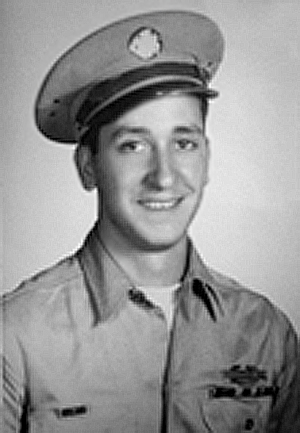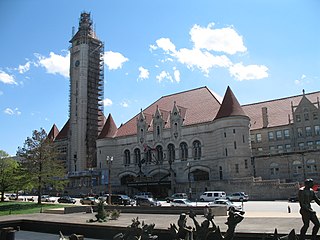
Kansas City, Missouri is the largest city in the U.S. state of Missouri by population and area. Most of the city lies within Jackson County, with portions spilling into Clay, Platte, and Cass counties. It is the central city of the Kansas City metropolitan area, which straddles the Missouri–Kansas state line and has a population of 2,392,035. As of the 2020 census, the city had a population of 508,090, making it the 37th most-populous city in the United States, as well as the sixth-most populous city in the Midwest. Kansas City was founded in the 1830s as a port on the Missouri River at its confluence with the Kansas River from the west. On June 1, 1850, the town of Kansas was incorporated; shortly after came the establishment of the Kansas Territory. Confusion between the two ensued, and the name Kansas City was assigned to distinguish them soon after.

The Kansas City metropolitan area is a bi-state metropolitan area anchored by Kansas City, Missouri. Its 14 counties straddle the border between the U.S. states of Missouri and Kansas. With 8,472 square miles (21,940 km2) and a population of more than 2.2 million people, it is the second-largest metropolitan area centered in Missouri and is the largest metropolitan area in Kansas, though Wichita is the largest metropolitan area centered in Kansas. Alongside Kansas City, Missouri, these are the suburbs with populations above 100,000: Overland Park, Kansas; Kansas City, Kansas; Olathe, Kansas; Independence, Missouri; and Lee's Summit, Missouri.

Canal Street is a major thoroughfare in the city of New Orleans. Forming the upriver boundary of the city's oldest neighborhood, the French Quarter or Vieux Carré, it served historically as the dividing line between the colonial-era (18th-century) city and the newer American Sector, today's Central Business District.

Crown Center is a shopping center and neighborhood located near Downtown Kansas City, Missouri between Gillham Road and Main Street to the east and west, and between OK/E 22nd St and E 27th St to the north and south. The shopping center is anchored by Halls, a department store which is owned and operated by Hallmark Cards. The neighborhood contains numerous residences, retail establishments, entertainment venues, and restaurants including the American Restaurant, the only Forbes Travel Guide four-star restaurant in Missouri. It is home to Hallmark Cards, and the headquarters of Shook, Hardy & Bacon and Lathrop GPM, two of Kansas City's largest law firms.

Downtown Kansas City is the central business district (CBD) of Kansas City, Missouri and the Kansas City metropolitan area which contains 3.8% of the area's employment. It is between the Missouri River in the north, to 31st Street in the south; and from the Kansas–Missouri state line eastward to Bruce R. Watkins Drive as defined by the Downtown Council of Kansas City; the 2010 Greater Downtown Area Plan formulated by the City of Kansas City defines the Greater Downtown Area to be the city limits of North Kansas City and Missouri to the north, the Kansas–Missouri state line to the west, 31st Street to the south and Woodland Avenue to the east. However, the definition used by the Downtown Council is the most commonly accepted.

Downtown Memphis, Tennessee is the central business district of Memphis, Tennessee and is located along the Mississippi River between Interstate 40 to the north, Interstate 55 to the south and I-240 to the east, where it abuts Midtown Memphis.

Quality Hill is a historic neighborhood near downtown Kansas City, Missouri, USA, on a 200-foot-high bluff which overlooks the confluence of the Kansas and Missouri rivers in the West Bottoms below.

The history of the Kansas City metropolitan area has significant records since the 19th century, when Frenchmen from St. Louis, Missouri moved up the Missouri River to trap for furs and trade with the Native Americans. This strategic point for commerce and security at the confluence of the Kansas and Missouri Rivers became the Kansas City metropolitan area, straddling the border between Missouri and Kansas. Kansas City, Missouri was founded in 1838 and surpassed the competing Westport to become the predominant city west of St. Louis. The area had a major role in the westward expansion of the United States. The Santa Fe and Oregon trails ran through the area. In 1854, when Kansas was opened to Euro-American settlement, the Missouri-Kansas border became the first battlefield in the conflict in the American Civil War.

The West Bottoms is a historic industrial neighborhood of Kansas City, Missouri, immediately west of downtown and straddling the border of Kansas City, Missouri and Kansas City, Kansas. At the confluence of the Missouri River and the Kansas River, it faces Kaw Point, an early campsite of the Lewis and Clark Expedition. The region was originally settled by the native tribes, and this spot was permanently settled as French Bottoms in the early 1800s by François Chouteau for his trade with the tribes and early American pioneers. It is one of the oldest areas of the metro along with Westport. Its neighboring Quality Hill neighborhood is a historical center of the pioneer Town of Kansas, which became Kansas City, Missouri.
The list of neighborhoods of Kansas City, Missouri has nearly 240 neighborhoods. The list includes only Kansas City, Missouri and not the entire Kansas City metropolitan area, such as Kansas City, Kansas.

Downtown Oklahoma City is located at the geographic center of the Oklahoma City metropolitan area and contains the principal, central business district of the region. The CBD has over 51,000 workers and over 12,000,000 sq ft (1,100,000 m2) of leasable office space to-date. Downtown Oklahoma City is the legal, financial, economic, nightlife, and entertainment center of the region.
Planning and development in Detroit since the late 20th century has attempted to enhance the economy and quality of life of Detroit, Michigan, United States. In 1970, the private group Detroit Renaissance began to facilitate development in the city. Its successor, Business Leaders for Michigan, has continued to facilitate development into the 21st century. Projects have included new commercial facilities, revitalization of neighborhoods, hospitality infrastructure, and improvements to recreational and public facilities, such as the QLine light rail project.

Downtown Omaha is the central business, government and social core of the Omaha–Council Bluffs metropolitan area, U.S. state of Nebraska. The boundaries are Omaha's 20th Street on the west to the Missouri River on the east and the centerline of Leavenworth Street on the south to the centerline of Chicago Street on the north, also including the CHI Health Center Omaha. Downtown sits on the Missouri River, with commanding views from the tallest skyscrapers.

Marion A. Trozzolo was an innovator, inventor, entrepreneur, and professor of business at Rockhurst University in Kansas City, Missouri. He was the first manufacturer of teflon coated cookware in the United States, and was the developer of the Kansas City entertainment district River Quay.
Grand Boulevard or Grand Avenue is a north/south street in Kansas City, Missouri, United States. Grand runs along the 200 east block in the Kansas City street grid system. In the Downtown and Crown Center areas of Kansas City, it is an arterial route, continuing on the north as the Grand Ave. Viaduct passing through Richard L. Berkley Riverfront Park and on the south intersecting with Main Street at about the 2800 South Block.
Main Street or Main is a one of the major streets in Kansas City, Missouri and the Kansas City metropolitan area. Main Street serves as the main administrative dividing line for house numbering and east–west streets in Kansas City; for example, it separates East 59th Street from West 59th Street. Address numbers on east–west streets increase in both directions as one moves away from Main Street. This should not be confused with the Kansas City "East Side" and "West Side," a cultural distinction which has arisen from a history of racist segregation in the city, separated by Troost Avenue approximately 1 mile east of Main Street.

Downtown West is a neighborhood in St. Louis, Missouri. It is, as the name suggests, a section of downtown that is further inland, west from the banks of the Mississippi River. St. Louis City Hall, the Metropolitan Police Headquarters, St. Louis Union Station, Stifel Theatre, Enterprise Center, and CityPark stadium are all located in Downtown West. The Washington Avenue Historic District is a former garment district consisting of turn of the previous century high rise warehouses converted into residential lofts, restaurants, taverns, and coffee shops. It is bounded by Jefferson Avenue on the west, Tucker Boulevard on the east, Cole Street on the north, and Chouteau Avenue on the south.

The KC Streetcar is in Downtown Kansas City, Missouri. Streetcar system construction began in May 2014 and opened for service on May 6, 2016. It is free to ride, as it is funded by a transportation development district. As of December 2023, the streetcar has had 13 million rides since opening in 2016. Extensions north to the riverfront and south to University of Missouri-Kansas City have been funded, with the southern extension under construction.
Kaw Township is one of eight townships in Jackson County, Missouri, United States. The township is within the city of Kansas City. As of 2010 census, its population was 182,719. The township was established in 1827 through an order of the county court.

















